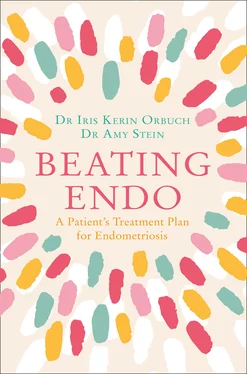“Okay,” said Amy, “but not giving up the CrossFit and running may actually be slowing the downregulation process. You’re going into hyperdrive to burn fat and calories, and your body can’t recover sufficiently. I really urge you again to switch to an elliptical machine in place of running. Just give up the high-intensity stuff until your system calms down, and in time, you will be able to slowly and carefully go back to it. Right now, instead, do some yoga, but not power yoga—the gentle form. And let me tailor a program of exercise for you that focuses on cardio, stretching, and some very specific hip and core strengthening.”
This time, Taylor agreed to change her exercise routine, to continue with the changed behaviors she had already initiated, and to keep up the weekly PT sessions Amy had prescribed. Three months later, she felt almost entirely “cured.” The two symptoms that still bothered her were the menstrual cramps and painful sex. Amy again emphasized that Taylor really needed to see an endo specialist and “get educated” about her disease process. “Not all ob-gyns are as knowledgeable as I would wish about what I suspect is happening to you, so let me refer you to a specialist.” She referred Taylor to Iris for a full consultation and a thorough examination.
For a start, Iris did her usual thorough history and physical exam. In the latter, she discovered the same sort of thickened ligaments behind the cervix she had seen in Elena—plus a uterus tilted backward; Iris could palpate the area to reproduce Taylor’s pain, and this confirmed her suspicion that Taylor most likely had endo. In fact, Iris estimated a 90 percent probability.
But since Taylor wasn’t yet ready to undergo surgery, Iris first recommended birth control pills to subdue the monthly pain, cautioning Taylor that the pills would treat only her symptoms, not her endo. “The birth control pills won’t keep your endo from progressing,” Iris cautioned her, “but they’ll relieve some of your symptoms.” Second, and conceivably more important, Iris had an extensive talk with her about the disease she was pretty certain Taylor had. She said she thought it likely that Taylor’s endo was decreasing her ovarian reserve and could compromise fertility later on, and she suggested to her that she might want to consider freezing some of her eggs because, while fertility decreases in women without endo at about age thirty-five, women with endo need to face potential fertility issues at an earlier age—in Taylor’s case, right now. Knowing this could be empowering for Taylor. “Come back and see me in three months,” Iris said as she handed Taylor the prescription for the birth control pills.
It was a wake-up call, and it worked. Certainly, the lifestyle changes and physical therapy had downregulated Taylor’s system, alleviated her hip and tailbone pain, and helped improve her bowel symptoms. Sex was less uncomfortable since she started doing PT, although deep penetration still hurt. The pill had also helped her menstrual cramps—she only needed a few Advil a day, not twelve. She had regained a good measure of quality of life by changing significant aspects of it. At that three-month follow-up, Taylor got a refill prescription for the birth control pills, a reminder that the endo inside her was still progressing, and a lot of knowledge about the need to seek out an excision specialist—wherever her career might take her.
For Taylor, along with the benefits of relief from symptoms was the reality of having to contemplate what the presence of endo could mean for her future. It was time to admit that she was up against a reality she could not dodge and a fact she might have to confront at any time. If her pain worsened, if her body responded in new ways to the disease process inside her, she had to be ready to respond with new strategies. Self-governance was important to Taylor; she felt good about all she had achieved in so effectively cooling her nervous system—and in general, in living a healthier life.
SARAH
Sarah, a transplanted Londoner, had suffered severe abdominal pain and disabling menstrual cramps ever since her first period as a young girl. She could not recall a single doctor ever asking her about her menstrual cycle. Finally, as a grown woman in her twenties still unable to get out of bed during her period, she sought medical help and was advised to undergo ablation surgery. That recommendation is the typical first response to presumed cases of endometriosis; it is as standard in the United Kingdom as it is in the United States and just about everywhere else.
Sarah underwent the procedure and felt some relief—at least for two cycles of her period—so she fully expected that the pain would continue to diminish. Instead it returned, worse than ever. Her surgeon examined her again and told her, “There is nothing else I can do.”
Meanwhile, Sarah met, fell in love with, and married an American and moved with him to a midsize town in a midsize state in the American Midwest. Her pain, which was not confined to her menstrual cycle but persisted with no rhyme or reason, was becoming disabling again, so she made an appointment with a local gynecologist, who told her that while he could perform a second ablation surgery, he did not think it would work to alleviate her pain. Instead, noting her complaint of bladder pain, he referred Sarah to a urologist.
The urologist diagnosed chronic urinary tract infection and put Sarah on a course of antibiotics. Once again, the relief she felt was gratifying—for the three days that it lasted. Then the pain returned again, worse than ever. But Sarah finished the full course of antibiotics before she went back to see the urologist again.
His solution was to try another round of antibiotics, which this time brought virtually no relief at all. This prompted an intense round of questioning to compile more details in a search for answers. What the doctor learned from this was that in addition to bladder problems, Sarah suffered from severe constipation—and was unaware of it. She typically moved her bowels once a week, had always done so, and thought it normal. Sarah was now referred to a gastroenterologist.
The gastroenterologist prescribed a daily pill and a daily stool softener. As was now usual—expected, anyway—Sarah felt a bit of relief at first, but after four months, there was no substantive improvement in her condition.
A friend of her husband’s suggested she see an endocrinologist, and an increasingly desperate Sarah made an appointment. The endocrinologist prescribed thyroid medication to raise Sarah’s low thyroid levels and, having noted for years a correlation between endo and autoimmune conditions, confirmed the possibility that Sarah might have an autoimmune disease. And, since the word endometriosis was floating in the air, he also suggested that Sarah get in touch with a New York–based endo specialist—namely, Iris.
Certainly, Sarah had traveled a long way since her family doctor back home in England told her that her pain was something she would “just have to live with,” so the prospect of a trip to New York seemed but another step in the journey and certainly worth trying. That was how she came to be in Iris’s office, where she answered Iris’s rash of questions, went through Iris’s hands-on, extensive physical examination, and heard Iris proclaim that there was “a high likelihood” that Sarah had endometriosis. Iris also recognized that Sarah’s pelvic floor muscles were extremely tight and sent her to Amy for physical therapy. Together, they prescribed a program for Sarah: It would start with understanding the disease process, changing to a low-acid, low-potassium, anti-inflammatory diet to address her interstitial cystitis/painful bladder, getting up and moving and beginning a specialized physical therapy program, moderating the disease’s impacts one by one, undertaking a program of mindfulness through meditation, yoga, qigong, or tai chi—and downregulating the nervous system as preparation for excision surgery, when the time was right.
Читать дальше











